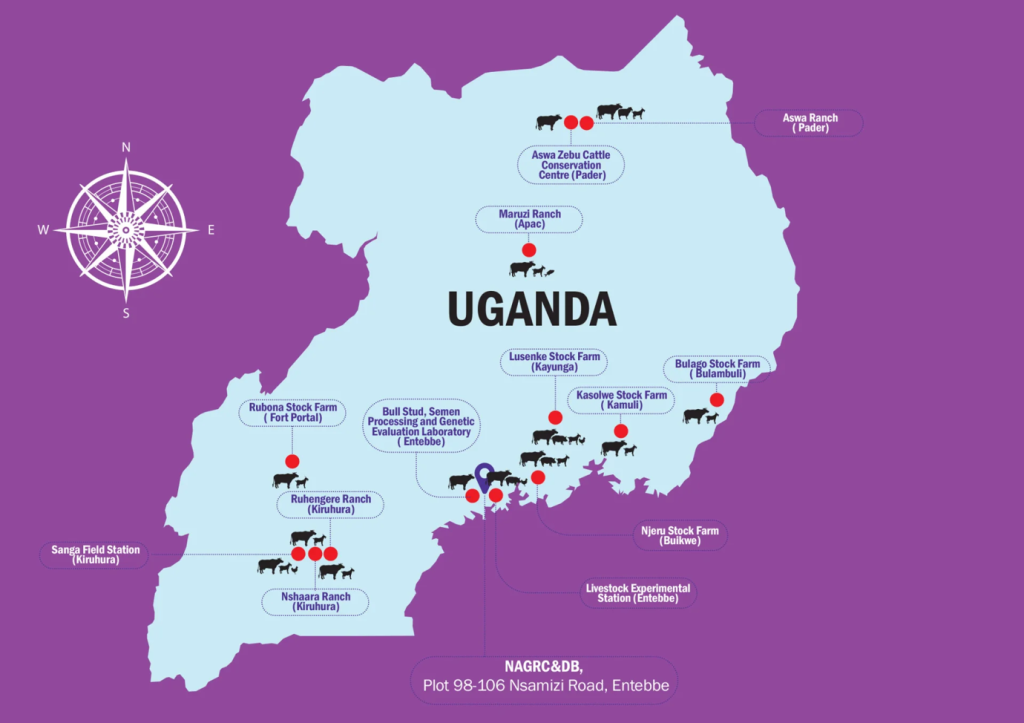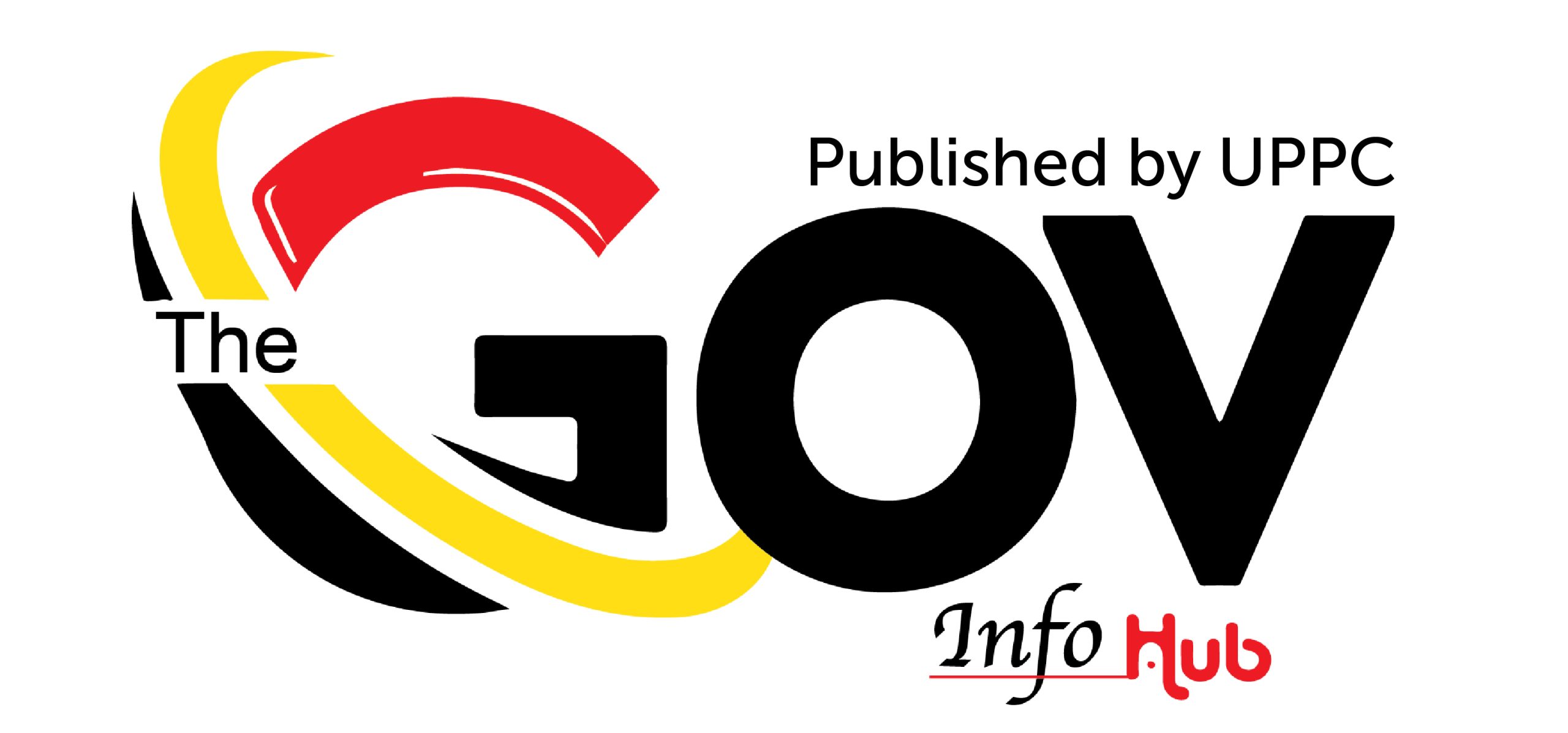The National Animal Genetic Resources Centre and Data Bank (NAGRC&DB) was established by the Animal Breeding Act of 2001 as a semi-autonomous entity under the Ministry of Agriculture, Animal Industry, and Fisheries (MAAIF).
Its formation fulfilled the objectives of the National Animal Breeding Policy (1997) and its Action Plan, providing strategic direction to stakeholders across the animal breeding and production value chain. These stakeholders—ranging from input suppliers and farmers to researchers, extension workers, and civic leaders—are guided on suitable breeding practices, conservation of indigenous genetic resources, and the use of modern breeding technologies. NAGRC&DB’s dual mandate is to lead the commercialization of animal breeding in Uganda and enhance genetic improvement and productivity across the livestock sector.
Goal
Enhancing the competitiveness and sustainability of the livestock industry
Vision
Establishing a comprehensive and sustainable National Animal Breeding Programme which meets the commercial and developmental interests of the actors along the livestock sub-sector value chains
Mission
A leader in profitable production and efficient delivery of animal genetic resources and services in Eastern and Central Africa
Commercial Activities
NAGRC&DB engages in a range of commercial activities, including:
- Sale of semen, eggs, ova, embryos, and related equipment.
- Management of farms for the production, selection, and sale of superior dams and sires.
- Rearing of sire studs for semen production and sale.
- Production and distribution of liquid nitrogen and associated equipment.
- Production and sale of founder broodstock for fisheries.
- Sale of properly bred livestock through open nucleus schemes.
- Procurement and distribution of breeding and reproductive equipment.
Development Activities
The development activities undertaken by NAGRC&DB include:
- Serving as the National Animal Genetic Data Bank.
- Acting as the National Central Livestock Registry.
- Operating as the National Animal Genetic Resources Evaluation Centre and Laboratory.
- Functioning as a national gene depository and examination center for genetic materials.
- Quarantining and evaluating imported genetic materials.
- Offering guidance on the breeding and multiplication of improved livestock breeds.
FARM LOCATIONS
NAGRC&DB operates 12 Government Animal Genetic Resource Centres (AnGRCs) strategically located across Uganda’s agro-ecological zones to support diverse animal production systems. The organization runs Uganda’s only nationally accredited bull stud, which produces semen for both domestic and regional markets, serving countries such as Burundi, South Sudan, and the Democratic Republic of Congo.
The NAGRC&DB breeding centres (farms & ranches) are used as:
- Sources of quality breeding stock
- Outreach breeding centres for the farmers in the districts that surround them
- Open nucleus breeding centres working with other identified nucleus farmers
- Sources of services like Embryo transfer, Artificial Insemination (AI) services, sources of AI inputs for the AI technicians working in the area
- Centres for training in breeding and feeding technologies and demonstration of other management aspects
- The farms shall also be used for business incubation of livestock incubatees, targeting youth and women.

List of farms under The National Animal Genetic Resources Centre and Data Bank (NAGRC&DB)
- Bulago Stock Farm
Location: Bulago Stock Farm is situated in Bulago trading center, Busia parish, Bulago sub-county, Elgon County, Bulambuli district. The farm benefits from two main seasons, with consistent rainfall during the first season and a dry period in the third quarter of the year.
Mandate:
- Pure dairy cattle and goat breeding
- Fish breeding (Carp species)
Species: Cattle, Goats, Fish
Breeds: Friesian dairy cattle, Saanen dairy goats, Carp fish
Aswa Ranch
Location:
Aswa Ranch is located in Burlobo village, Angagura sub-county, Aruu North, Pader district. It borders Gulu to the south, Lamwo to the northeast, and Kitgum to the north. The ranch covers 132 square miles, spanning Angagura, Atanga, and Laguti sub-counties, and is bordered by the Aswa River to the west and the Pager River to the north.
Mandate:
- Leadership in beef cattle upgrading and breeding
- Apiculture center
- Feedlot demonstration and animal feed production
Species: Cattle
Breeds: Ankole cattle, Brahman crosses, with upgrading through the use of Brahman, Romagnola, and Boran semen
Key Agro-Enterprises/Production Activities:
- Open nucleus breeding with the Acholi sub-region community
- Liquid nitrogen storage facilities serving the northern region
- Aswa Zebu Cattle Conservation Centre
Location: Located within the Aswa Ranch, Burlobo village, Angagura sub-county, Aruu North, Pader district.
Mandate: Conservation and development of the Short-horn Zebu cattle
Species: Cattle
Breeds: Short-horn Zebu
- Kasolwe Stock Farm
Location: Kasolwe Stock Farm is located in Kagumba sub-county, Kamuli district, serving the Busoga sub-region. It spans approximately 2,000 acres.
Mandate:
- Pure dairy cattle breeding
- Conservation of pure Zebu cattle and their upgrading with Jersey breeds
- Grandparent pig breeding program
- Poultry breeding
- Fish breeding
- Animal feed production
- Conservation and development of the indigenous Kasolwe brown goat
Species: Cattle, Goats, Pigs, Poultry, Fish
Breeds:
- Cattle: Jersey, Zebu
- Goats: Kasolwe brown goat
- Pigs: Large White, Landrace, Piétrain, Duroc
- Poultry: Dual-purpose scavenging poultry
- Fish: Tilapia, Catfish, Mirror Carp
Key Agro-Enterprises/Production Activities:
– Medium-scale animal feed production and processing, with a high-capacity hay barn storing up to 35,000 bales of hay
Livestock Experimental Station (LES)
Location: Located in Wakiso district near Entebbe International Airport, the farm covers about 80 acres and hosts the National Gene Bank and the Regional Gene Bank for Eastern Africa.
Mandate:
- Exotic dairy cattle breeding
- Pig breeding
- Poultry production
Species: Dairy Cattle, Poultry, Pigs
Breeds:
- Cattle: Jersey, Friesian, Guernsey, Ayrshire, Brown Swiss
- Poultry: Kuroiler, Rainbow Roosters
- Pigs: Landrace, Large White, Duroc
Key Agro-Enterprises/Production Activities:
- Pure dairy cattle breeding
- Multi-purpose poultry production
- Lusenke Stock Farm
Location: Lusenke Stock Farm is located in Busana sub-county, Kayunga district, straddling the River Nile and covering approximately 7 square miles.
Mandate:
- National goat resources center
- Crossbreeding Zebu cattle with Tyrolean Grey
- Pure breeding of dairy cattle
- Grandparent pig breeding program
- Goat and poultry breeding
Species: Dairy and dual-purpose cattle, Poultry, Pigs, Goats
Breeds:
- Cattle: Tyrolean Grey, Ayrshire
- Goats: Dairy and meat goats
- Pigs: Large White, Landrace, Piétrain, Duroc
- Poultry: Kuroiler, Rainbow Rooster
Key Agro-Enterprises/Production Activities:
- Nucleus breeding for dairy production (bulls and heifers)
- Leadership center for goat breeding
- Dairy and beef upgrading of Zebu cattle with Tyrolean Grey, Jersey, and Red Angus breeds
- Nshaara Ranch
Location: Nshaara Ranch is located in Kiruhura District, Nyabushozi County, bordering Lake Mburo National Park, and covers 27 square miles.
Mandate:
- Conservation of Ankole cattle
- Upgrading of Mubende goats with South African Boer goats
Species: Cattle, Goats
Breeds:
- Cattle: Ankole long-horn
- Goats: South African Boer goat crosses
Key Agro-Enterprises/Production Activities:
- Source of Ankole cattle for breeding, development, and multiplication into beef and dairy lines
- Crossbreeding Ankole cattle for various programs
- Production of tropicalized South African Boer goats
- Maruzi Ranch
Location: Maruzi Ranch is located in Akokoro sub-county, Apac district, in the Northern Region.
Mandate:
- Beef cattle and goat upgrading
- Selection and multiplication of fish broodstock
Species: Cattle, Goats, Fish
Breeds:
- Cattle: Ankole, Boran, Sahiwal, Brahman, Romagnola crosses
- Goats: Small East African, Mubende goats
- Fish: Tilapia, Catfish
Specialized Units
Data Bank Unit for Animal Genetic Resources
NAGRC&DB spearheads the management, conservation, and utilization of Uganda’s animal genetic resources. Through a dedicated Data Bank, the center centralizes genetic data, supports genetic improvement efforts, preserves indigenous breeds, and contributes to the long-term sustainability of the livestock sector.
Semen Production, Packaging, Storage, and Distribution Unit
This unit oversees the acquisition, collection, processing, storage, and distribution of semen for artificial insemination (AI). It ensures that high-quality semen is available for breeders and farmers, evaluates imported semen to meet international standards, and conducts regular post-thaw semen evaluations in both laboratory and field settings.
Poultry Development Unit
The Poultry Development Unit is responsible for the breeding and reproduction of poultry through research-driven approaches. It provides farmers with high-quality, affordable Kuroiler and Rainbow Rooster chicks, ensuring efficient poultry production across Uganda while maintaining meticulous breeding records.
Foundation Fish Broodstock and Fry Production Unit
This unit focuses on sustainable fish genetic development and the conservation of indigenous fish genetic resources. It monitors breeding activities, provides training to fish breeders and farmers, and fosters associations for fish breeders. The unit also plays a key role in addressing the increasing demand for fish through aquaculture and conservation efforts.
Liquid Nitrogen Production and Distribution Unit
NAGRC&DB operates three liquid nitrogen production plants that serve the needs of Uganda’s livestock breeding programs. Located in Entebbe, Buikwe District, and Mbarara, these plants produce liquid nitrogen essential for the storage and distribution of genetic materials.
National Pig Breeding Program
This program focuses on improving the genetic quality of pigs to meet the needs of farmers and the market. Through strategic breeding programs, research, and dissemination of best practices, the program has improved productivity and genetic diversity in Uganda’s pig sector. It also conserves indigenous pig genetics at Njeru Stock Farm, ensuring the sustainability of local breeds.
Apiculture Unit
The Apiculture Unit supports modern, market-oriented beekeeping as a profitable enterprise. It empowers farmers with practical skills in apiculture, promoting environmental conservation and economic development. The unit also spearheads efforts to conserve the indigenous African bee species, *Apis mellifera adansonii*, through cryopreservation and in-situ conservation.
Animal Feed Production Unit
This unit is dedicated to pasture seed multiplication and industrial feed production. It plays a crucial role in improving the nutritional needs of livestock through research, innovation, and the development of feed tailored to different animal species and production stages.
National Livestock Quarantine Centre
The National Livestock Quarantine Centre ensures the health and biosecurity of Uganda’s livestock by preventing the spread of infectious diseases. It adheres to international biosecurity standards, thereby safeguarding public health and supporting international trade.
Community-Based Animal Breeding Program (CBBP)
The CBBP empowers smallholder farmers to actively participate in livestock genetic improvement. Guided by animal geneticists, communities set breeding objectives and select breeding stock, utilizing modern genetic tools such as genomics to enhance productivity and resilience.
Assisted Reproductive Technologies (ARTs) Unit**
This unit facilitates genetic improvement and disease control through advanced breeding technologies such as embryo transfer, sperm sexing, and cloning. ARTs are crucial for enhancing reproductive efficiency, controlling diseases, and conserving endangered species, all while optimizing livestock productivity.

